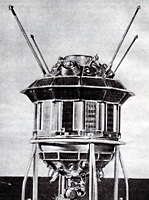Date: October 7, 1959
Luna 3 was the third spacecraft in a series of Soviet spacecraft that was launched towards the Moon. This spacecraft was the first to bring back images of the far side of the moon, the part that cannot be seen from Earth. The pictures it returned were not very clear, but digital enhancements made the mapping of the side of the Moon possible.
 |
| http://nssdc.gsfc.nasa.gov/thumbnail/spacecraft/luna_3.gif |
The camera onboard detected the Moon as Luna 3 went by it. It started to automatically take shots. When the photos were taken, the film went under development, and the final prints were then scanned. Through a different process, the images were able to be sent as radio signals towards Earth. “The first image was taken at 03:30 UT at a distance of 63,500 km from the Moon's surface and the last 40 minutes later from 66,700 km. A total of 29 photographs were taken, covering 70% of the far side” (NASA.gov). After it completely took all of the shots, it revolved back towards Earth, and the images were transmitted as it got closer to it.
By October 22, contact was lost with the probe, and the date that it burned up on is unknown, though it is believed to be between 1960 and 1962.
No comments:
Post a Comment